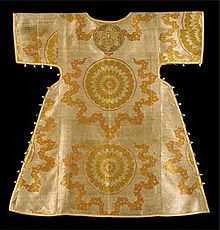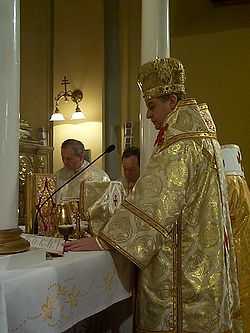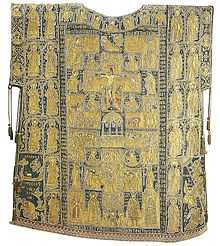Sakkos



The sakkos (Greek: σάκκος, "sackcloth"[1]) is a vestment worn by Orthodox and Greek Catholic bishops instead of the priest's phelonion. The garment is a tunic with wide sleeves, and a distinctive pattern of trim. It reaches below the knees and is fastened up the sides with buttons or tied with ribbons. It is similar in form to the western dalmatic, which is similarly derived from Byzantine dress. The sakkos was originally worn by the Emperor as an imperial vestment, symbolizing the tunic of disgrace worn by Christ during his trial and mockery.
The sakkos is usually made of a rich brocade fabric and may be intricately embroidered. There is normally a cross in the center of the back, which the bishop kisses before it is placed on him. Buttons or loops are sewn on the back, by which the bishop's omophorion (either great or small) may be attached. Traditionally, bells are attached to the sakkos, following the biblical directions for the vestments of the Jewish High Priest (Exodus 28:33-34; 39:25-26).
History
Originally, all bishops wore a phelonion similar to the one worn by priests, but woven or embroidered with a multilayered cross pattern called the polystavrion ("many-crosses"). The use of the sakkos was a privilege bestowed by the Basileus (Emperor) upon individual patriarchs as a sign of his personal favor. The first literary evidence for the garment is found in the writings of Theodore Balsamon, Patriarch of Antioch (ca. 1130–1140). By the 13th century it worn by all the patriarchs and a few high-ranking archbishops—but only on Easter and the Great Feasts of Pentecost and Nativity; other bishops continued to wear the polystavrion. After the Fall of Constantinople (1453) it came into general use by bishops along with the mitre, derived from the Imperial crown, as a sign of their temporal authority within the Rum millet of the Ottoman Empire. The sakkos is now worn by all Eastern Orthodox and Byzantine Catholic bishops, regardless of rank. Unlike Western pontificalia which may be worn by prelates who are not bishops—provided they have the privilege of doing so—the sakkos may only be worn by a bishop.
Use

The bishop wears the sakkos when he vests fully to celebrate the Divine Liturgy, at the Great Doxology at Matins when there is an All-Night Vigil, or on specific other occasions when called for by the rubrics (for instance, at the bringing out of the Epitaphios on Great and Holy Friday, or the cross on the Great Feast of the Exaltation). At other services, he will wear the episcopal mantle (Greek: Μανδύας, Mandýas, Old Church Slavonic: Mantiya). When the bishop is vested, the sakkos is presented to him on a tray. He blesses it with both hands, and two subdeacons lift it off the tray, hold it for him to kiss the cross on the back, place it on him and button the sides (as shown here). The epigonation, which was placed on the bishop first, is lifted up as the sakkos is buttoned, so that it remains visible on the outside. During the vesting with the sakkos, the protodeacon swings the censer and says the Prayer of the Sakkos:
Thy high priests shall by clothed in glory, and Thy saints shall rejoice with joy, always, now and ever, and unto the ages of ages. Amen.
This prayer is identical to that used by a priest when he vests in the phelonion, except that instead of saying "Thy high priests", a priest says simply, "Thy priests".
In some traditions, a bishop may choose to celebrate the Liturgy "as a priest"; meaning he does not vest in full episcopal vestments, nor does he make use of the dikirion and trikirion (episcopal candlesticks). Instead of the sakkos he wears a priestly phelonion, with only the small omophorion on his shoulders and the epigonation at his side. The bishop will in this instance, as always, wear his Panagia enkolpion, and will stand on the eagle rug. Moreover, certain ceremonial practices are not observed as they would be for a full hierarchal service.
A bishop may theoretically always use the phelonion rather than the sakkos, but this is very rarely done. A notable instance where the phelonion is always used is in the Liturgy of St. James. The phelonion was originally used by both the presbyters and the bishops of the church. However, as the Roman Empire drew to a close, the Ecumenical Patriarch began wearing the sakkos, due to being the "Ecumenical" Patriarch, that is, the Patriarch of the imperial capital and most of the Empire. After the Empire fell, the Turks appointed most Orthodox Bishops to wear the sakkos. This was also the period in which Orthodox Bishops began wearing imperial mitres and also were seated on a throne off to the side, rather than the center near where the original ambo would have been. The Slavic Churches retain standing the Bishops in the center of the Church, but during various reforms, began wearing mitres and the sakkos as the Greeks did. Though it should also be noted, that the Russian Patriarch/Metropolitan already wore a mitre similar to the one he wears today, and other Russian Bishops adopted the mitres of the Greeks only later.
References
- ↑ Sokolof, Archpriest D. (1916), A Manual of the Orthodox Church's Divine Services, Jordanville, N.Y.: Printshop of St. Job of Pochaev (published 2001), p. 31
External links
- Vatican Sakkos Byzantine (Constantinople or Thessalonike), 14th century
- Saccos (sakkos) of patriarsh Nikon, 1654
- "Kolomensky" Sakkos of Patriarch Nikon.
- Sakkos of Patriarch Joachim.